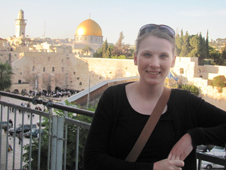Using hip-hop to promote peace

From the Sugarhill Gang to Sean “Diddy” Coombs, hip-hop has not only influenced fashion and culture throughout the world, but may even have the power to ease decades of social conflict, says recent Northeastern University alumna Karin Heim, AMD’11.
In the paper, “Beats Not Bombs: Hip-Hop to Create Peace in the Israeli-Palestinian Conflict,” Heim investigates how artists use rap as a tool to help the people of Israel find common ground in the conflict. The paper was published recently in Nota Bene, an international undergraduate journal of musicology at the University of Western Ontario.
“If musicians want to build a better Israel, a more peaceful Israel, it really starts with them setting a good example for young people listening to their music,” said Heim, who majored in music history and analysis.
Heim wrote the paper as part of Northeastern’s Dialogue of Civilizations program to Israel where, a year ago, she studied social conflict at Ben-Gurion University Be’er Sheva and Haifa University. The program requires participants to research a topic relating to the curriculum.
“I knew I wanted to incorporate my music background into the research, but knew little about the music scene in Israel or how it could possibly relate to the conflict,” Heim said about the paper.
Associate professor of sociology and anthropology, Gordana Rabrenovic, who runs the Dialogue in Israel in partnership with the Brudnick Center for the Study of Violence and Conflict at Northeastern, helped Heim to define her research topic.
“Karin’s paper is a great example of how experiential learning and academics come together in a meaningful way,” she said.
Heim found that Middle East hip-hop artists — like the musician Subliminal, who has been described as Israel’s Eminem, and the Arab-Israeli group DAM — are using music to condemn violence, a notion that appeals to young Jewish-Israelis, Arab-Israelis, and Palestinians. Like the artists themselves, Heim found these youths use hip-hop to define their religious, ethnic, and social group identities.
Through hip-hop, Arab-Israeli rapper SAZ and Jewish-Israeli rapper Sagol 59, have been able to collaborate in an open dialogue about their frustrations with society and hopes for a peaceful coexistence.
They performed together at a popular Tel Aviv nightclub as part of a “Hip-Hop Sulha,” a series of globe-spanning performances featuring Jewish and Arab artists, which aimed to create a musical platform for discourse and understanding.
“These examples show us that artists can use hip-hop to promote dialogue and create understanding between different groups in Israel,” Heim concluded.
Rabrenovic agrees, “Through the shared interest in music, people of different backgrounds connect to each other as human beings, and from there can begin to work together.”
But, in the end, both Heim and Rabrenovic say it would be too much of a burden to expect musicians to bring peace to Israel. Rather, it is a process that requires a mix of political, economic, social, and cultural cooperation.




